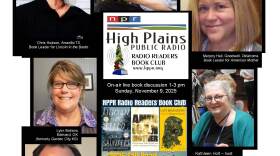This is Mike Strong, in Hays, for HPPR. The book is “How the Post Office Created America” by Winifred Gallagher.
As the United States expanded in the 1800’s, communication needs also expanded. Mail service was social media. People would write to tell relatives where they were and what they were doing. So, when Facebook’s subject line entices us with “Mamie Smith was in Hays …..” the line is far from new.
But where was “here?” And who was “here?” A communication system needs to link identities with locations, whether phone number, email, website or “mailing address.” Community names went through the Post Office, much as website URLs go through ICANN to be listed.
The naming of the Nebraska town I was born in, Norfolk, was never totally clear to me, until reading Winifred Gallagher. She explains that the Post Office devised a system based on assigned names tied to locations.
Some people used the names of leading citizens, others went for civic boosterism, “Ideal, Georgia” for example. Or “Paradise.” Who wouldn’t want to live in Paradise?
Before long there were so many new post offices that a rule had to be set up that no two communities in the same state could have the same name. Good for states, but that meant that my other hometown, the one I grew up in from third grade, was one of 27 Columbus’ in the US when I looked it up in a gazetteer in 7th grade.
A mailing address contains the information needed to locate one particular, physical spot to send physical goods to you, such as the mailbox on your house.
Like a phone book listing, a website name is text, such as KCDance.com. It is called a URL (Universal Resource Locator). This text name is “resolved” into an IP address (similar to a phone number) which locates a particular computer.
The N-O-R-F-O-L-K in Nebraska is NOT pronounced “NORE-folk” – matching its spelling, as are all the other N-O-R-F-O-L-K spellings in the rest of the world. Nope, No siree!
In Nebraska you treat the “L” in “N-O-R-F-O-L-K” as if it were an “R.” In 1857, the good folk who were settling on the north fork of the Elkhorn River wanted a Post Office in order to get mail delivery. To get postal service the locals, writes Gallagher, had to form a community and name it.
90 years before I was born, my civic ancestors wanted the name “North Fork,” reflecting their location on the Elkhorn River. Only, it didn’t work out that way.
I’ve always imagined that whoever the settlers in that spot sent to the capital with their petition was sent without a paper petition. He would have said, “North Fork” smooshing the two words together the way people today still say “NOR-fork.” Maybe the official at the Post Office heard it as the already familiar “Norfolk” and put that down on paper. And I further guess that the official could read and write, if not hear properly, while the petitioner could not read and write, but was good at mumbling.
Or, I thought, maybe there was already a place in Nebraska named “North Fork.” I’m guessing not. I googled for “North Fork Nebraska” and got multiple results, most referring to N-O-R-F-O-L-K Nebraska. Nothing referencing a perhaps long ago, now long-gone town of that same name.
One search result made me burst out laughing, an 1863 painting by Albert Bierstadt of the area around North Platte, Nebraska titled “North Fork of the Platte Nebraska.” Mountains and woody terrain which existed only in his paint brush. This is where The North Platte and South Platte River join to form the Platte River.
I’ve driven through there many times and lived there in kindergarten when my single mom, as a newly minted teacher, secured a teaching job in North Platte. There were never mountains.
So, when in Norfolk, Anywhere-Else, you are good for “NORE-folk.”
But, when in Nebraska, you’d durn well best say, “NORE-FORK,” even today, more than 165 years later. Or they will know, you - are - a - tourist!
This is Mike Strong, in Hays, for HPPR Radio Readers Book Club.










